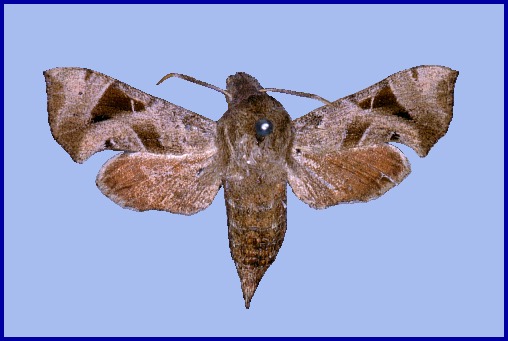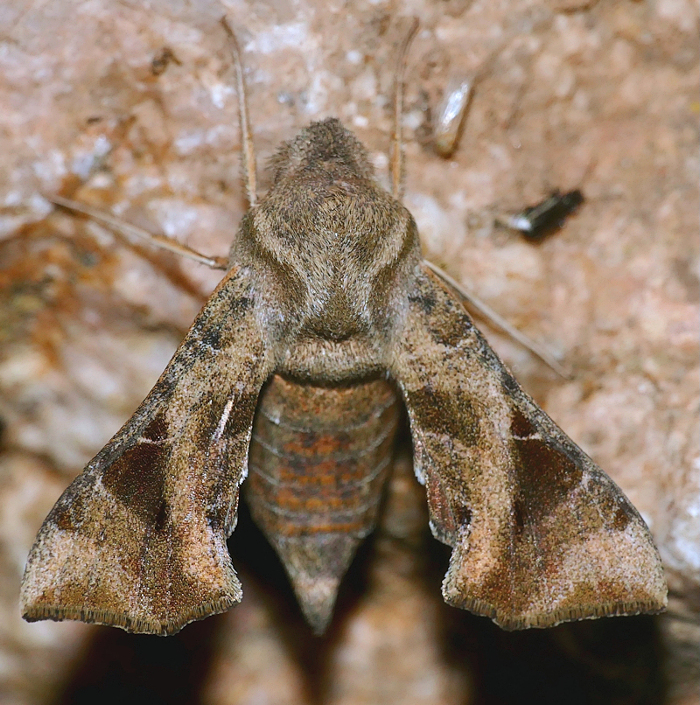UK: Savanna Hawkmoth; Hawklet
Lophura nana Walker, 1856, List Specimens lepid. Insects Colln. Br. Mus. 8: 107.Type locality: Natal, South Africa.
[Further details on this species, as well as photos of all stages, can be found on AfroMoths.]
Palaeotropical; Afrotropical region.

Wingspan: 25--30mm. A very small, brown, blunt-winged moth which is very easily overlooked.

Crepuscular. Frequents savanna, steppe and semi-desert at about 1000m. In Africa, often seen hovering at flowers well before nightfall.
March and April; however, a specimen captured at Jiroft, Kerman (Iran), in early October (3-4.x.1993) indicates a second generation (Kitching & Zahiri, 2007).
OVUM: Small (size unrecorded), spherical, pale green.
LARVA: Full-fed, 40mm. Polymorphic: green, reddish or whitish.
The larval description given by Carcasson (1968) (and repeated by Pittaway, 1993) is that of the related Sphingonaepiopsis ansorgei (Rothschild, 1904). The actual larva of Sphingonaepiopsis nana is that wrongly given by Pinhey (1962, plate 14, figure 19) as Sphingonaepiopsis ansorgei. The fully grown larva of Sphingonaepiopsis nana is generally green with a strong, white lateral line edged with orange-brown, and a thin, straight anal horn. The latter is laterally compressed and slightly spatulate in Sphingonaepiopsis ansorgei.
Instead of being voided as individual pellets, the frass forms 'sticks' 1--4cm in length.
Occurs mainly during April and May.
Hostplants. Various Rubiaceae, including Kohautia, Galium, Rubia and Plocama.
PUPA: Similar in shape to that of Hyles. Yellowish olive with intersegmental sutures black on thorax and brown on the abdomen, the latter with a dark green dorsal stripe and transverse lines of small, black dots. Wings with black lines from base to just before termen, interrupted in discoidal cell. Eyes, proboscis, antennae and legs outlined in black. Apex of abdomen black, cremaster a short black spike. Formed in a loosely-spun cocoon of brown silk among debris on the ground (Carcasson, 1976). The overwintering stage.
None recorded.
Kerman Province (Jiroft, near Kerman, 1850m), Hormozgan Province (Issin, 130m) and Baluchistan, southern Iran (Daniel, 1961; Kitching & Zahiri, 2007), and western Saudi Arabia (north to Jeddah) (Wiltshire, 1990). This is essentially a moth of the Afrotropical zoogeographical region which just enters the western Palaearctic region. However, as Jiroft is located at 1850m altitude this may indicate that this species can tolerate cold, dry conditions and may thus be found in many other areas of Iran, or even western Pakistan.
Extra-limital range. The southern Arabian Peninsula (including the UAE (Gillett & Howarth, 2007), the Prosopis/Acacia dominated coastal plain of northern Oman (E. P. Wiltshire, pers. comm.; Hacker, 2016), and Yemen (Butler, 1884)), eastern Africa to Natal, and thence westwards to The Gambia (Kitching & Zahiri, 2007).
 Return to species list
Return to species list